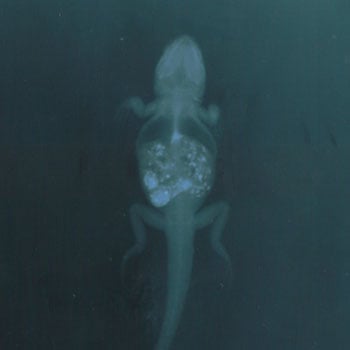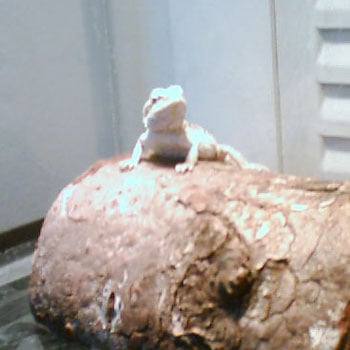Written by Alex Sleeis and Denise Bushnell on July 7, 2006
Also, some food items may not be easily digestible, particularly feeder insects with hard chitin shells, such as large crickets, mealworms, or superworms. Feeding insects such as these to your bearded dragon (especially juvenile bearded dragons) puts them at an increased risk of developing an impaction.
The packaging of many substrates claims that they are completely digestible. However, please be very wary of claims from the manufacturers of these products. Unlike products for human consumption or use, the safety of products used for our pets is under no such regulation.
Before you trust a substrate, please research what those with lots of personal experience think about it. For example, many calcium-based substrates (including, but not limited to Calci-Sand) not only claim that their substrate is digestible but also that it is beneficial for your bearded dragon's health if they ingest it because it is a source of calcium for them. However, a bearded dragon may eat more of this substrate than is good for them if they need additional calcium in their diet. And they are NOT digestible, as they claim. Combine the difficulty of digestion with the increased likelihood of ingestion, and you may have a very sick bearded dragon.
An indicator of a more serious issue could be partial paralysis. Typically, a beardie's hind legs seem to have less mobility and often drag as your beardie moves. If you see this happening, it could be that he has an impaction. Of course, it may be something other than impaction, but it's definitely a problem that needs your immediate attention.
Another sign, often accompanied by the paralysis mentioned above, is a bump or lump along the back near the spine. Like paralysis, this is usually an indication of a more serious problem and should be cared for immediately.
I recommend that you get your pet an appointment as soon as possible with a knowledgeable vet who is experienced in treating bearded dragons. If you are still looking for an experienced reptile vet in your area, you can get assistance by logging onto HerpVetConnection.com. This site lists veterinarians experienced in treating reptiles by state.
Another good source of information is an article entitled "Impaction in Bearded Dragons," which is available at ReptileRooms.com, written by Cheri Smith. She goes into much more detail about what you can do to help treat the issue.
 Impaction has been explained many times. I frequently see it discussed in numerous forums on this site. We recently (at the time of this writing) had one discussion in particular, in which the poster provided the X-ray image of their pet's impaction. It was a severe case. The bearded dragon was kept on play sand covered with a layer of Calci-sand. Unfortunately, the beardie managed to eat the sand (a lot of it). This X-ray image was the most astounding illustration I've ever seen to make people aware that this is a very real and dangerous issue, not just an exaggeration.
Impaction has been explained many times. I frequently see it discussed in numerous forums on this site. We recently (at the time of this writing) had one discussion in particular, in which the poster provided the X-ray image of their pet's impaction. It was a severe case. The bearded dragon was kept on play sand covered with a layer of Calci-sand. Unfortunately, the beardie managed to eat the sand (a lot of it). This X-ray image was the most astounding illustration I've ever seen to make people aware that this is a very real and dangerous issue, not just an exaggeration.
Yes, all those bright areas in the belly are sand! As one of our forum members commented, this beardie was more like a "Rock with a tail" than a normal, healthy beardie. However, in this particular case, this picture is worth a thousand words and illustrates the seriousness of the problem much more effectively than words ever could.
 And to illustrate, in some cases, with proper medical care, impaction does not have to be a death sentence. For example, the following photo is the same bearded dragon, feeling much better now and well on his way to a complete recovery.
And to illustrate, in some cases, with proper medical care, impaction does not have to be a death sentence. For example, the following photo is the same bearded dragon, feeling much better now and well on his way to a complete recovery.
The owner of this bearded dragon said of the medical treatment, "They gave him an enema, some laxatives, and a shot of calcium, and he passed it that next morning, and he is doing awesome now."
It is nice to hear that this particular episode had a happy ending! Special thanks go to "Hoth" for authorizing us to use these images of their little beardie, "Draco."
What is impaction?
Impaction is a condition where a solid or semi-solid mass blocks a bearded dragon's digestive tract.Causes of Impaction
Food Items
Several things may cause this condition. One possible cause is if a bearded dragon is permitted to eat food items too large to move through their digestive tract properly. The best prevention for this is remembering that a good rule of thumb for determining the right size for food items is that any item fed should be smaller than the space between your bearded dragon's eyes.Also, some food items may not be easily digestible, particularly feeder insects with hard chitin shells, such as large crickets, mealworms, or superworms. Feeding insects such as these to your bearded dragon (especially juvenile bearded dragons) puts them at an increased risk of developing an impaction.
Inadequate Temperatures
Another problem related to feeding is that a bearded dragon needs appropriate temperatures to digest their food. Generally, the surface on which a bearded dragon basks following a meal should be maintained at 100 to 115 degrees to digest their food correctly. If a bearded dragon is fed a food item that is difficult to digest and is not provided with the proper temperatures for him to digest that food, this may also place him at an increased risk for impaction.Dangerous Substrates
Another major contributor to impaction is the ingestion of substrate. Many particulate substrates can pose a risk. In many cases, Calci-Sand has been reported to have caused impaction. However, it is not alone; pellets (such as Rabbit Pellets), pebble-like substrates, and several dried plant-based substrates are also known to present a high risk. Play sand can also cause impaction if ingested regularly or if a great deal is ingested at once.The packaging of many substrates claims that they are completely digestible. However, please be very wary of claims from the manufacturers of these products. Unlike products for human consumption or use, the safety of products used for our pets is under no such regulation.
Before you trust a substrate, please research what those with lots of personal experience think about it. For example, many calcium-based substrates (including, but not limited to Calci-Sand) not only claim that their substrate is digestible but also that it is beneficial for your bearded dragon's health if they ingest it because it is a source of calcium for them. However, a bearded dragon may eat more of this substrate than is good for them if they need additional calcium in their diet. And they are NOT digestible, as they claim. Combine the difficulty of digestion with the increased likelihood of ingestion, and you may have a very sick bearded dragon.
How will I know my bearded dragon is impacted?
There are a few signs that you may notice. One of the first indications is that your beardie will stop going to the bathroom regularly. Typically, your beardie will have a bowel movement (i.e., poop) once a day. Now this is not a hard and fast rule since every bearded dragon is different, but if your bearded dragon has not moved his bowels in a couple of days, and is not acting like his usual self, be sure to pay attention. This may be an indication that something serious is going on.An indicator of a more serious issue could be partial paralysis. Typically, a beardie's hind legs seem to have less mobility and often drag as your beardie moves. If you see this happening, it could be that he has an impaction. Of course, it may be something other than impaction, but it's definitely a problem that needs your immediate attention.
Another sign, often accompanied by the paralysis mentioned above, is a bump or lump along the back near the spine. Like paralysis, this is usually an indication of a more serious problem and should be cared for immediately.
What can I do about it?
I am not a medical expert on this topic, so I am hesitant to offer any detailed guidance on dealing with impaction properly. With the earlier stages of a mild impaction, you may be able to offer your bearded dragon some relief by giving him a warm bath and gently massaging his abdomen. Massaging gently down towards the vent may assist your bearded dragon in moving an impaction down through his digestive tract so that he can pass it. Another thing that may help is to dose your bearded dragon with a few drops of vegetable oil before bathing him to help move things along more easily.I recommend that you get your pet an appointment as soon as possible with a knowledgeable vet who is experienced in treating bearded dragons. If you are still looking for an experienced reptile vet in your area, you can get assistance by logging onto HerpVetConnection.com. This site lists veterinarians experienced in treating reptiles by state.
Another good source of information is an article entitled "Impaction in Bearded Dragons," which is available at ReptileRooms.com, written by Cheri Smith. She goes into much more detail about what you can do to help treat the issue.
So what happens when your bearded dragon is impacted?

Yes, all those bright areas in the belly are sand! As one of our forum members commented, this beardie was more like a "Rock with a tail" than a normal, healthy beardie. However, in this particular case, this picture is worth a thousand words and illustrates the seriousness of the problem much more effectively than words ever could.
But there's good news

The owner of this bearded dragon said of the medical treatment, "They gave him an enema, some laxatives, and a shot of calcium, and he passed it that next morning, and he is doing awesome now."
It is nice to hear that this particular episode had a happy ending! Special thanks go to "Hoth" for authorizing us to use these images of their little beardie, "Draco."
